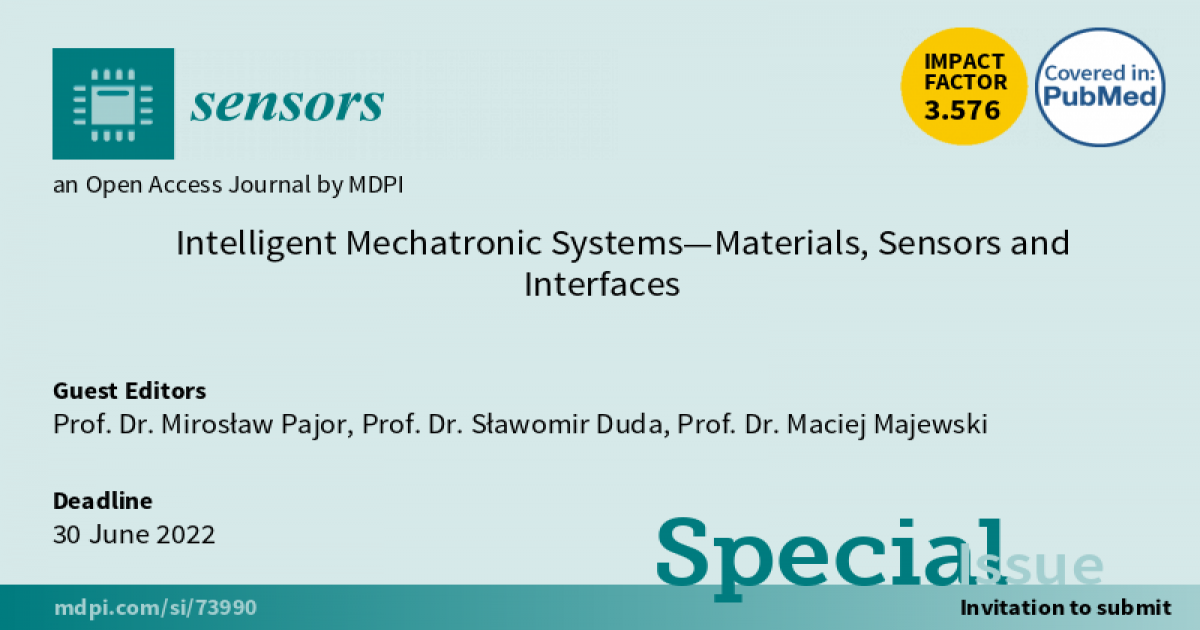Intelligent Mechatronic Systems—Materials, Sensors and Interfaces
A special issue of Sensors (ISSN 1424-8220). This special issue belongs to the section "Intelligent Sensors".
Deadline for manuscript submissions: closed (30 June 2022) | Viewed by 44714

Special Issue Editors
Interests: modeling and research of machining processes; dynamics of machine tools and robots; designing of machine diagnostic systems; intelligent man-machine interfaces and mechatronics
Special Issues, Collections and Topics in MDPI journals
Interests: dynamics of electromechanical systems; feedback control of dynamic systems; vibration with control; smart materials; smart sensors
Special Issues, Collections and Topics in MDPI journals
Interests: interaction; data engineering; intelligent systems; machine learning; mechatronic systems; natural language processing
Special Issues, Collections and Topics in MDPI journals
Special Issue Information
Dear Colleagues,
We are currently accepting contributions covering, but not limited to, the following topics:
- Intelligent mechatronic systems in manufacturing and industrial robotics;
- Intelligent mechatronic systems and cyber-physical production systems;
- Intelligent mechatronic systems using Internet of Things (IoT);
- Intelligent mechatronic systems in smart factories;
- Decision support systems using artificial intelligence methods for mechatronic systems;
- Innovative human–machine interactions for intelligent mechatronic systems;
- Industrial big data analytics in Industry 4.0;
- Artificial intelligence applications in mechatronic systems;
- Intelligent materials;
- Innovative use of new materials;
- Testing the properties and structure of materials in Industry 4.0.
Prof. Dr. Mirosław Pajor
Prof. Dr. Sławomir Duda
Prof. Dr. Maciej Majewski
Guest Editors
Manuscript Submission Information
Manuscripts should be submitted online at www.mdpi.com by registering and logging in to this website. Once you are registered, click here to go to the submission form. Manuscripts can be submitted until the deadline. All submissions that pass pre-check are peer-reviewed. Accepted papers will be published continuously in the journal (as soon as accepted) and will be listed together on the special issue website. Research articles, review articles as well as short communications are invited. For planned papers, a title and short abstract (about 100 words) can be sent to the Editorial Office for announcement on this website.
Submitted manuscripts should not have been published previously, nor be under consideration for publication elsewhere (except conference proceedings papers). All manuscripts are thoroughly refereed through a single-blind peer-review process. A guide for authors and other relevant information for submission of manuscripts is available on the Instructions for Authors page. Sensors is an international peer-reviewed open access semimonthly journal published by MDPI.
Please visit the Instructions for Authors page before submitting a manuscript. The Article Processing Charge (APC) for publication in this open access journal is 2600 CHF (Swiss Francs). Submitted papers should be well formatted and use good English. Authors may use MDPI's English editing service prior to publication or during author revisions.
Keywords
- mechatronic systems
- intelligent materials
- innovative materials
- virtual reality
- computer numerical control (CNC) systems
- control systems
- robotics
- electromechanical systems dynamics
- vibration and control
- smart sensors
- interaction
- human–machine interface and teaming
- decision support
- machine learning
- autonomous robotics
- Industry 4.0
- manufacturing
Benefits of Publishing in a Special Issue
- Ease of navigation: Grouping papers by topic helps scholars navigate broad scope journals more efficiently.
- Greater discoverability: Special Issues support the reach and impact of scientific research. Articles in Special Issues are more discoverable and cited more frequently.
- Expansion of research network: Special Issues facilitate connections among authors, fostering scientific collaborations.
- External promotion: Articles in Special Issues are often promoted through the journal's social media, increasing their visibility.
- e-Book format: Special Issues with more than 10 articles can be published as dedicated e-books, ensuring wide and rapid dissemination.
Further information on MDPI's Special Issue policies can be found here.








